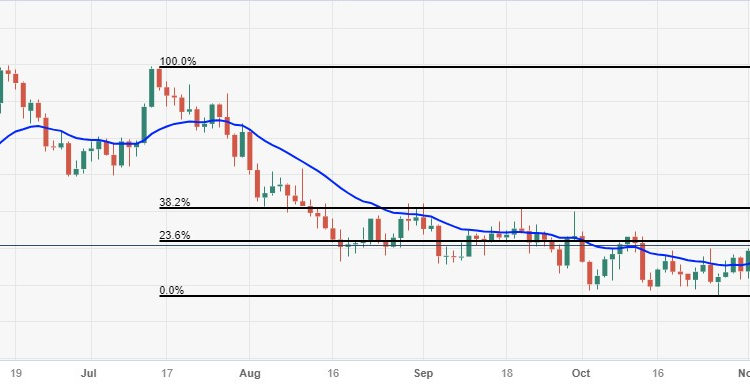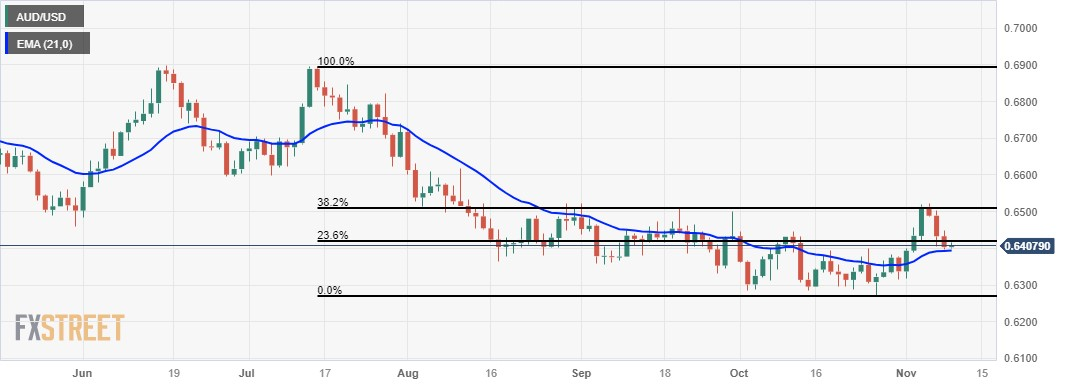Australian Dollar consolidates post intraday gains amid downbeat China CPI
- Australian Dollar looks to snap a three-day losing streak.
- Australia’s central bank made a dovish rate statement, weakening the AUD.
- China's CPI declined by 0.2% against the expected decline of 0.1%.
- Investors adopt a cautious stance as Fed officials resist the notion of lowering interest rates.
The Australian Dollar (AUD) attempts to snap a three-day losing streak on the subdued US Dollar (USD), which could be attributed to the downbeat US Treasury yields. However, the AUD/USD pair experienced downward pressure following a dovish rate statement by the Reserve Bank of Australia (RBA) post the policy decision.
Australia’s central bank opts for a data-dependent strategy in response to the persistent challenges posed by inflation and a slowing Australian economy. This approach was underscored by the RBA's decision on Tuesday to raise the Official Cash Rate (OCR) from 4.10% to a 12-year high of 4.35%. The move was a direct response to the latest revealed Monthly Consumer Price Index (YoY) for September, indicating a notable increase of 5.6%, surpassing the expected 5.4% growth.
China's inflation data showed an annual decline in October, exceeding the expected fall. The monthly figures dropped compared to the growth recorded earlier.
The AUD/USD pair confronts challenges amid a tepid market atmosphere this week, with investors awaiting fresh cues before making any moves, especially in light of the upcoming US Federal Reserve (Fed) decision in December.
Cautious sentiment prevails as Fed officials resist the idea of lowering interest rates. Investors will likely focus on the upcoming weekly US Jobless Claims report for potential market impact. Additionally, market participants anticipate insights from Federal Reserve Chair Jerome Powell, who is scheduled to participate in a panel discussion later in the day, focusing on “Monetary Challenges in a Global Economy.”
Daily Digest Market Movers: Australian Dollar attempts to halt the losing streak on the downbeat Greenback
- The RBA has resumed policy tightening, raising the Official Cash Rate (OCR) from 4.10% to 4.35% after maintaining the benchmark interest rate unchanged for four consecutive meetings.
- Australia’s TD Securities Inflation (YoY) fell to 5.1% in September from 5.7% prior.
- Australia’s Retail Sales grew 0.2% in the third quarter after contracting by 0.6% in the previous quarter.
- Economists at the National Australia Bank (NAB) anticipate another 25 basis points hike in February following the Q4 inflation data. Additionally, NAB believes that rate cuts are unlikely to commence until November 2024.
- China's Consumer Price Index (CPI) witnessed an annual decline of 0.2% in October, compared to the expected 0.1% decrease. The monthly CPI dropped by 0.1%, contrasting with the earlier 0.2% growth.
- Pan Gongsheng, the Governor of the People's Bank of China (PBOC), expressed optimism in a statement on Wednesday, saying that China's economy is on a positive trajectory and that it is anticipated to achieve the 5% growth target successfully.
- Additionally, the International Monetary Fund (IMF) has adjusted its outlook for China's Gross Domestic Product (GDP) growth, now projecting a 5.4% growth rate in 2023, up from the initial forecast of 5.0%, and 4.6% in 2024, surpassing the previous estimate of 4.2%.
- Fed Governor Michelle Bowman reinforced the opinion that the US Fed is contemplating future increases in short-term interest rates. Moreover, Neil Kashkari, President of the Minnesota Fed, questioned whether the central bank had raised rates sufficiently. Kashkari cited the economy's resilience as a factor influencing his perspective.
- The US Bureau of Labor Statistics recently unveiled the Nonfarm Payrolls (NFP) data for October, disclosing a figure of a 150K increase in jobs. This missed the expected 180K and marked a substantial drop from September's 297K.
Technical Analysis: Australian Dollar hovers around 0.6400 aligned with 21-day EMA
The Australian Dollar hovers around the major support at 0.6400 psychological level on Thursday, with the additional backing of the 21-day Exponential Moving Average (EMA) at 0.6394. A decisive breach below the latter could propel the AUD/USD pair towards a descent, targeting the November low at 0.6318. On the upside, the immediate resistance is the 23.6% Fibonacci retracement at 0.6417, followed by the psychological level at 0.6500 aligned with the 38.2% Fibonacci retracement level at 0.6508.
AUD/USD: Daily Chart
Australian Dollar price today
The table below shows the percentage change of Australian Dollar (AUD) against listed major currencies today. Australian Dollar was the weakest against the New Zealand Dollar.
| USD | EUR | GBP | CAD | AUD | JPY | NZD | CHF | |
| USD | 0.01% | 0.00% | -0.01% | -0.10% | 0.05% | -0.25% | 0.04% | |
| EUR | -0.01% | -0.01% | -0.03% | -0.11% | 0.04% | -0.27% | 0.02% | |
| GBP | -0.01% | 0.01% | -0.02% | -0.10% | 0.05% | -0.26% | 0.03% | |
| CAD | 0.01% | 0.03% | 0.02% | -0.07% | 0.06% | -0.24% | 0.05% | |
| AUD | 0.10% | 0.13% | 0.10% | 0.09% | 0.15% | -0.16% | 0.13% | |
| JPY | -0.05% | -0.05% | -0.06% | -0.08% | -0.15% | -0.31% | -0.02% | |
| NZD | 0.25% | 0.29% | 0.26% | 0.25% | 0.16% | 0.31% | 0.28% | |
| CHF | -0.03% | -0.01% | -0.02% | -0.03% | -0.15% | 0.03% | -0.30% |
The heat map shows percentage changes of major currencies against each other. The base currency is picked from the left column, while the quote currency is picked from the top row. For example, if you pick the Euro from the left column and move along the horizontal line to the Japanese Yen, the percentage change displayed in the box will represent EUR (base)/JPY (quote).
RBA FAQs
The Reserve Bank of Australia (RBA) sets interest rates and manages monetary policy for Australia. Decisions are made by a board of governors at 11 meetings a year and ad hoc emergency meetings as required. The RBA’s primary mandate is to maintain price stability, which means an inflation rate of 2-3%, but also “..to contribute to the stability of the currency, full employment, and the economic prosperity and welfare of the Australian people.” Its main tool for achieving this is by raising or lowering interest rates. Relatively high interest rates will strengthen the Australian Dollar (AUD) and vice versa. Other RBA tools include quantitative easing and tightening.
While inflation had always traditionally been thought of as a negative factor for currencies since it lowers the value of money in general, the opposite has actually been the case in modern times with the relaxation of cross-border capital controls. Moderately higher inflation now tends to lead central banks to put up their interest rates, which in turn has the effect of attracting more capital inflows from global investors seeking a lucrative place to keep their money. This increases demand for the local currency, which in the case of Australia is the Aussie Dollar.
Macroeconomic data gauges the health of an economy and can have an impact on the value of its currency. Investors prefer to invest their capital in economies that are safe and growing rather than precarious and shrinking. Greater capital inflows increase the aggregate demand and value of the domestic currency. Classic indicators, such as GDP, Manufacturing and Services PMIs, employment, and consumer sentiment surveys can influence AUD. A strong economy may encourage the Reserve Bank of Australia to put up interest rates, also supporting AUD.
Quantitative Easing (QE) is a tool used in extreme situations when lowering interest rates is not enough to restore the flow of credit in the economy. QE is the process by which the Reserve Bank of Australia (RBA) prints Australian Dollars (AUD) for the purpose of buying assets – usually government or corporate bonds – from financial institutions, thereby providing them with much-needed liquidity. QE usually results in a weaker AUD.
Quantitative tightening (QT) is the reverse of QE. It is undertaken after QE when an economic recovery is underway and inflation starts rising. Whilst in QE the Reserve Bank of Australia (RBA) purchases government and corporate bonds from financial institutions to provide them with liquidity, in QT the RBA stops buying more assets, and stops reinvesting the principal maturing on the bonds it already holds. It would be positive (or bullish) for the Australian Dollar.



Comments are closed.